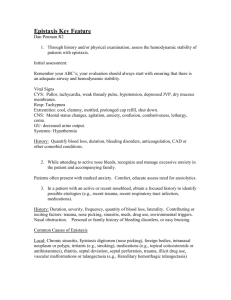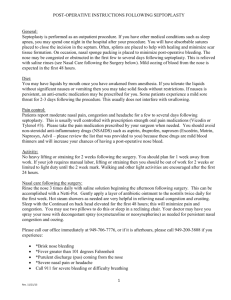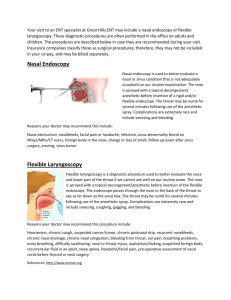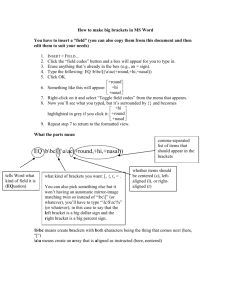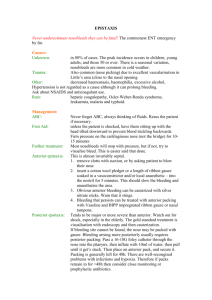Anterior Nasal Packing Procedure: A Learning Guide
advertisement
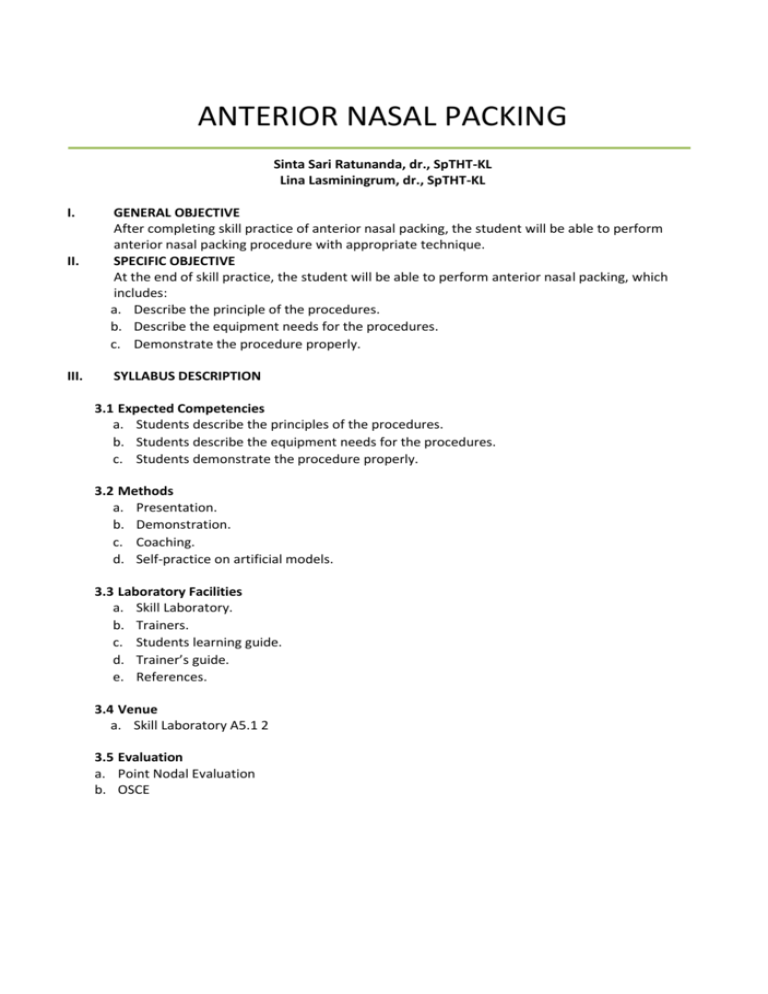
ANTERIOR NASAL PACKING Sinta Sari Ratunanda, dr., SpTHT-KL Lina Lasminingrum, dr., SpTHT-KL I. II. III. GENERAL OBJECTIVE After completing skill practice of anterior nasal packing, the student will be able to perform anterior nasal packing procedure with appropriate technique. SPECIFIC OBJECTIVE At the end of skill practice, the student will be able to perform anterior nasal packing, which includes: a. Describe the principle of the procedures. b. Describe the equipment needs for the procedures. c. Demonstrate the procedure properly. SYLLABUS DESCRIPTION 3.1 Expected Competencies a. Students describe the principles of the procedures. b. Students describe the equipment needs for the procedures. c. Students demonstrate the procedure properly. 3.2 Methods a. Presentation. b. Demonstration. c. Coaching. d. Self-practice on artificial models. 3.3 Laboratory Facilities a. Skill Laboratory. b. Trainers. c. Students learning guide. d. Trainer’s guide. e. References. 3.4 Venue a. Skill Laboratory A5.1 2 3.5 Evaluation a. Point Nodal Evaluation b. OSCE IV. EQUIPMENT 1. Presentation: Audiovisual: Slides presentations on LCD projector. 2. Demonstration and coaching: a. Head lamp b. Nasal speculum c. Tongue blade d. Pinset e. Petrolatum or Vaseline gauze coated with an antibacterial ointment f. cotton with anesthetic solution ± epinephrine (Lidocaine/ pehacain) g. gauzes h. Masker i. Hand gloves j. tape k. kidney basin l. scissor m. antiseptic solution n. Antibiotic ointment o. antiseptic soap LEARNING GUIDE ANTERIOR NASAL PACKING PROCEDURE No 1. 2. 3. 4. 5. 6. 7. 8. 9. 10. 11. 12. 13. 14. 15. 16. 17. 18. 19. Step / Task A. CLIENT ASSESSMENT Greet the patient respect fully and with kindness introduce yourself. The patient should be given adequate explanation about examinations. Explain the goals or the expected result examination. Check the instrument & material B. PREPARATION Wash your hands first with antiseptic soap and dry it with paper tissue. Self-protection: put on hand gloves + masker. Put the head lamp. ask the patient to sit ++ C. PROCEDURES Hold the nasal speculum with one hand and then put in on the left or right nostril. Hold it with the thumb on the joint, the index finger free to steady it on the patient’s nose and the rest of the fingers on the stem proper to hold the speculum. Always try to open the stem or times in an upward action and not down into the floor or the nose. The good view of the nose anteriorly can be obtained simply by pressing on the tip of the nose. Don’t close the speculum while its tip is in the nasal cavity Check the source of bleeding in both nostrils and oropharynx. Determine the location of bleeding. Administered the topical anesthesia. A pledged or cotton swab soaked in 1% Pantocaine or lidocaine solution (with or without containing 1-2 drops of an epinephrine solution dilutes 1:1,000) is placed in the nose for 3-5 minutes. After 3-5 minutes, remove the cotton and recheck the bleeding from the nose Next, the traditional anterior pack petrolatum gauze (0.5 x 72 inch) is firmly packed into the nasal cavity. The packing is placed in a methodical (layering) fashion toward the posterior choana, starting at nasal floor and packing up to about the level middle turbinate. It is possible to put a large amount into each side Great care must be taken that : - The free-end of the packing should not be visible in the oropharynx behind the soft palate as this can lead to irritation, an also a danger that this portion might slip deeper into the aerodigestive tract and cause complication. a. If the gauze is in the oropharynx repeat procedures. b. Fix the nasal packing with gauze and tape in front of nasal cavity. Take all of the instruments to the antiseptic solution. Take off the hand gloves, masker & head lamp. Once the gauze is firmly packed properly into the nasal cavity : - If needed, the patient should be admitted and kept under careful observation. - If needed, give the patient humidifies oxygen - As the pack will be left in for at least 48 hours, put the patient an broad spectrum antibiotic. Performance Scale 1 2 3 18. - If needed, establish an intravenous line, and cross-match the blood. After 48 hour: remove the nasal packing with circular motion and then check if there is any bleeding from nasal and oropharynx. TOTAL Note: 0 = not doing at all 1 = do the step partially 2 = do the step completely

